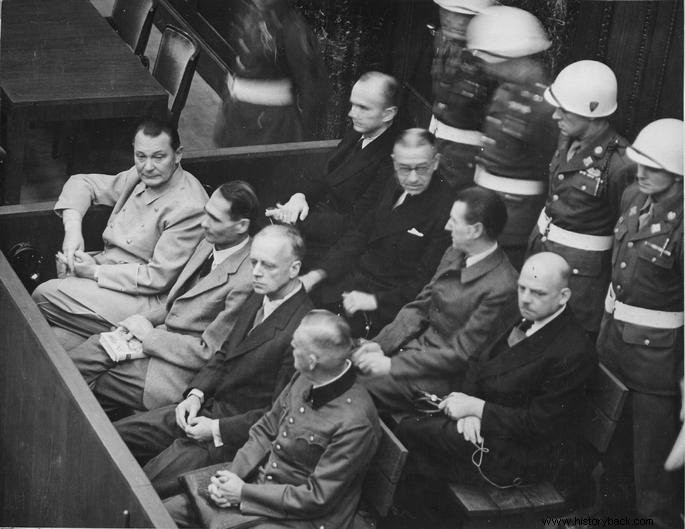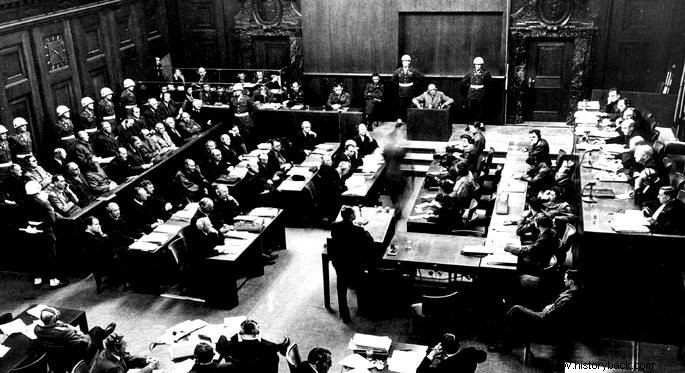The Nuremberg Court was an international court created in 1945 to judge crimes committed by the Nazis during World War II.
The trials began on November 20, 1945 and ended on October 1, 1946.
In total, 185 people were charged with 35 acquitted.
Creation of the Nuremberg Tribunal

When World War II ended, the winning countries – United Kingdom, United States, France and the Soviet Union - installed a court to try the Nazis.
For the first time in history, those responsible for a conflict were brought to justice. With this, the Allies wanted to give a moral meaning to the military victory. The Nuremberg Tribunal was composed of American, British, French and Russian judges.
The city of Nuremberg was not chosen by chance. It was there that Adolf Hitler had gathered his supporters for numerous congresses and enacted the first anti-Semitic laws.
39 doctors and lawyers sat on the benches with the accused; 56 members of the Nazi Party and the Police; 42 industrialists and managers; 26 military leaders and 22 ministers and senior government officials.
The most influential participants in the war, however, were not judged. Adolf Hitler (1889-1945), German Chancellor, committed suicide after learning of Germany's defeat by the Allies.
Heinrich Himmler, SS commander and supervisor of the concentration camps, had also committed suicide; and Joseph Goebbels, Minister of Propaganda. Certain officers and doctors who worked directly in the extermination of Jews like Josef Mengele, were on the run.
See also:NazismNuremberg Trials

The Nuremberg Tribunal was responsible for prosecuting criminals involved in murder, extermination, slavery, deportation, abuse of power, among other crimes.
The most awaited trial was that of the 24 officers who worked in the Nazi government structure or in the Armed Forces.
These responded for the crimes of conspiracy; crimes against peace; war crimes and crimes against humanity.
See also:Anti-SemitismConvicted by the Nuremberg Tribunal
Most of the defendants took the blame for the charges they received, however, they claimed they were just following orders from above.
The most severe penalties were applied to those who directly acted in the mass execution of people and contributed to the Final Solution project, in which the physical elimination of all Jews in Europe was planned. .
During the trial of the participants of the Nazi hierarchy, 219 sessions were held and the court handed down its verdict on October 1, 1946.
Of the 24 tried, 12 were sentenced to death, three were acquitted, three got life imprisonment and four were confined to prison for 15 to 20 years.
Among those sentenced to death by the Nuremberg Tribunal are Nazi Party leaders such as Alfred Rosenberg and ministers such as Joachim von Ribbentrop. Commanders of occupied territories such as Hans Frank and heads of the armed forces such as Hermann Göring also received capital punishment.
The Nuremberg Tribunal ushered in a new era for international law and war crimes by showing that justice could be applied in any territory.
See also:Holocaust:what it was and how it happenedCriticism of the Nuremberg Tribunal
The Nuremberg Tribunal was criticized from a legal point of view because it violated a number of rules.
The principle of territoriality was changed, as the Germans were tried by magistrates from other countries and, in addition, the accusers formed part of the court, something that is prohibited.
The Court only considered the German Nazis to be war criminals. No other person of nationality other than the German or political ideology that the Nazi was accused of.
Like it? There are more texts on this topic for you :
- Films about the Second World War
- Consequences of World War II
- Adolf Hitler
